Analysis of Management and Leadership in Oracle: Case Study Report
VerifiedAdded on 2020/01/23
|17
|4957
|464
Report
AI Summary
This report provides a detailed analysis of leadership and management principles, using Oracle as a case study. It begins by differentiating between the roles of leaders and managers, emphasizing the importance of motivation, clear vision, and effective communication. The report then explores various leadership theories, including situational, system, and contingency leadership, assessing their applicability to organizational growth and operational management. It examines how leaders set objectives and managers execute plans, highlighting the significance of risk assessment and task-oriented leadership. The analysis also covers the application of leadership theories, such as telling, selling, participating, and delegating, to different organizational situations. The report concludes by assessing the applicability of conventional theories to the organization and how they support growth, providing a comprehensive understanding of effective leadership and management practices within a business context.
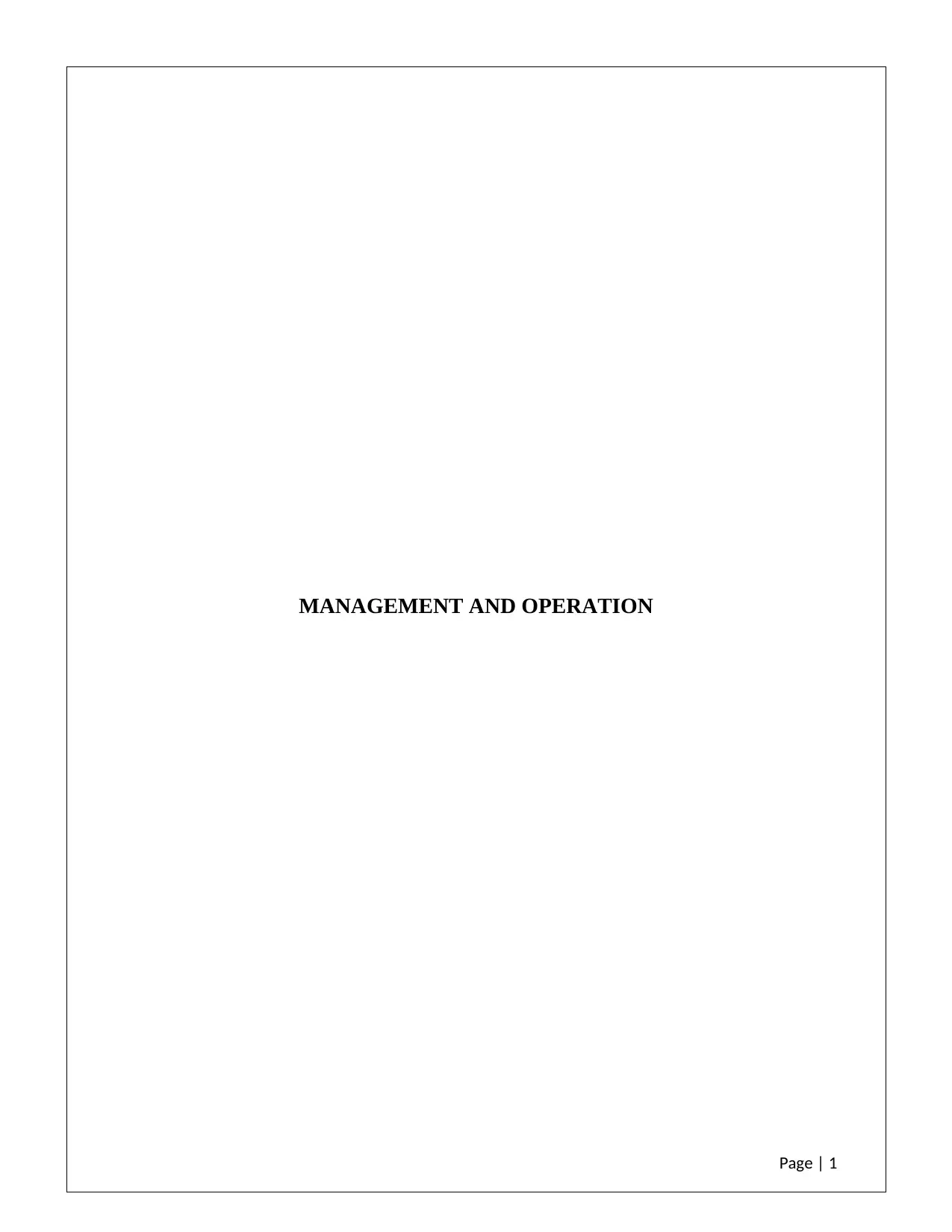
MANAGEMENT AND OPERATION
Page | 1
Page | 1
Paraphrase This Document
Need a fresh take? Get an instant paraphrase of this document with our AI Paraphraser
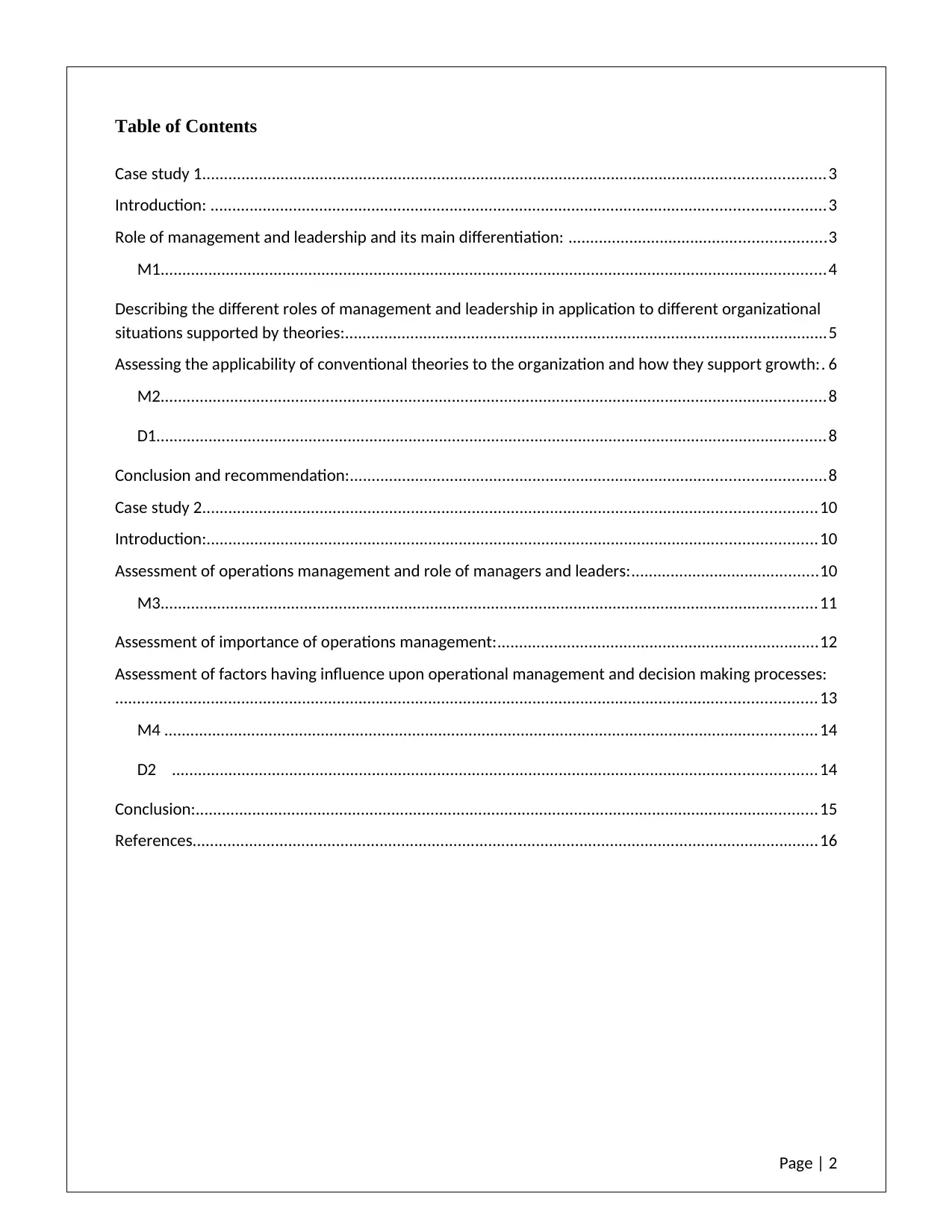
Table of Contents
Case study 1...............................................................................................................................................3
Introduction: .............................................................................................................................................3
Role of management and leadership and its main differentiation: ...........................................................3
M1.........................................................................................................................................................4
Describing the different roles of management and leadership in application to different organizational
situations supported by theories:...............................................................................................................5
Assessing the applicability of conventional theories to the organization and how they support growth:. 6
M2.........................................................................................................................................................8
D1..........................................................................................................................................................8
Conclusion and recommendation:.............................................................................................................8
Case study 2.............................................................................................................................................10
Introduction:............................................................................................................................................10
Assessment of operations management and role of managers and leaders:...........................................10
M3.......................................................................................................................................................11
Assessment of importance of operations management:..........................................................................12
Assessment of factors having influence upon operational management and decision making processes:
.................................................................................................................................................................13
M4 ......................................................................................................................................................14
D2 ....................................................................................................................................................14
Conclusion:...............................................................................................................................................15
References................................................................................................................................................16
Page | 2
Case study 1...............................................................................................................................................3
Introduction: .............................................................................................................................................3
Role of management and leadership and its main differentiation: ...........................................................3
M1.........................................................................................................................................................4
Describing the different roles of management and leadership in application to different organizational
situations supported by theories:...............................................................................................................5
Assessing the applicability of conventional theories to the organization and how they support growth:. 6
M2.........................................................................................................................................................8
D1..........................................................................................................................................................8
Conclusion and recommendation:.............................................................................................................8
Case study 2.............................................................................................................................................10
Introduction:............................................................................................................................................10
Assessment of operations management and role of managers and leaders:...........................................10
M3.......................................................................................................................................................11
Assessment of importance of operations management:..........................................................................12
Assessment of factors having influence upon operational management and decision making processes:
.................................................................................................................................................................13
M4 ......................................................................................................................................................14
D2 ....................................................................................................................................................14
Conclusion:...............................................................................................................................................15
References................................................................................................................................................16
Page | 2
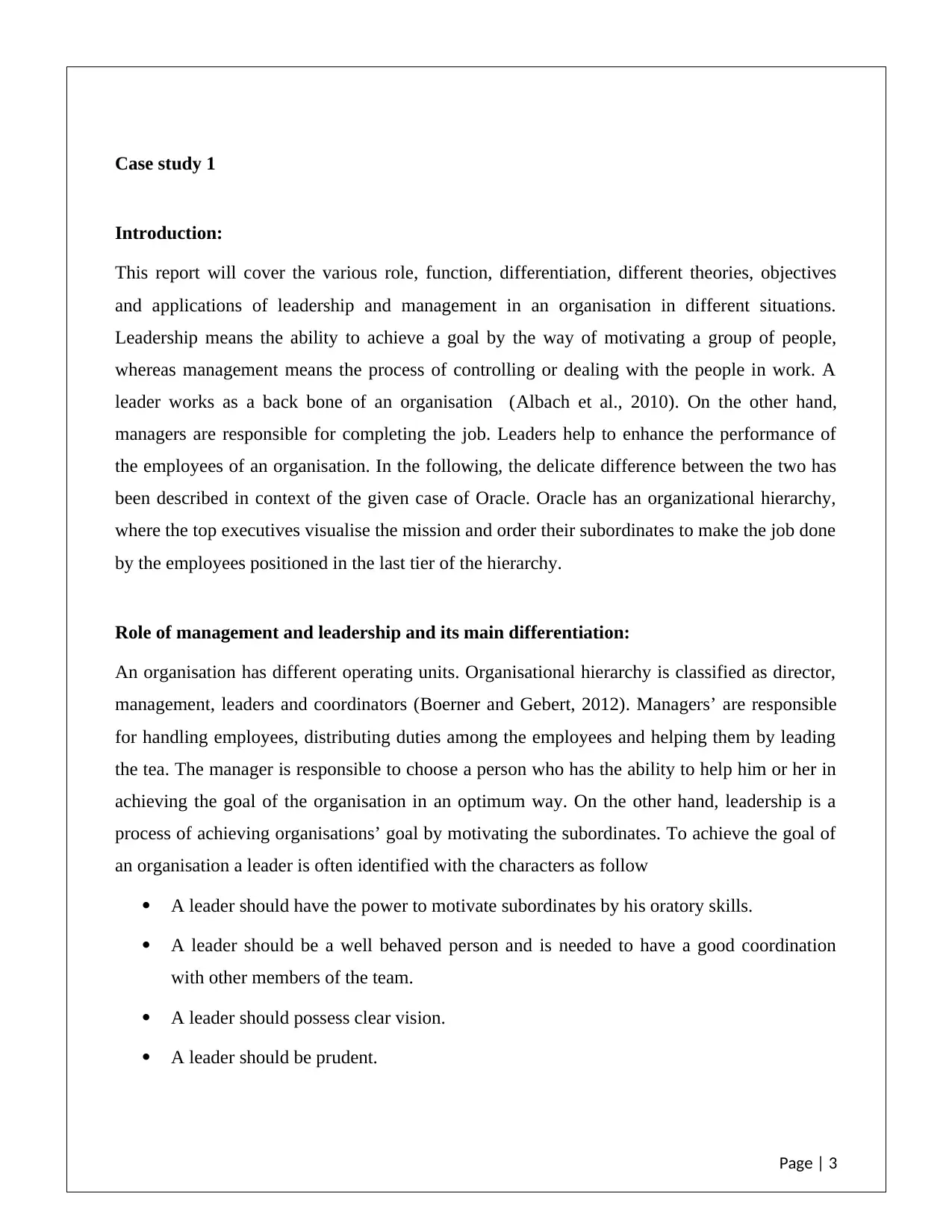
Case study 1
Introduction:
This report will cover the various role, function, differentiation, different theories, objectives
and applications of leadership and management in an organisation in different situations.
Leadership means the ability to achieve a goal by the way of motivating a group of people,
whereas management means the process of controlling or dealing with the people in work. A
leader works as a back bone of an organisation (Albach et al., 2010). On the other hand,
managers are responsible for completing the job. Leaders help to enhance the performance of
the employees of an organisation. In the following, the delicate difference between the two has
been described in context of the given case of Oracle. Oracle has an organizational hierarchy,
where the top executives visualise the mission and order their subordinates to make the job done
by the employees positioned in the last tier of the hierarchy.
Role of management and leadership and its main differentiation:
An organisation has different operating units. Organisational hierarchy is classified as director,
management, leaders and coordinators (Boerner and Gebert, 2012). Managers’ are responsible
for handling employees, distributing duties among the employees and helping them by leading
the tea. The manager is responsible to choose a person who has the ability to help him or her in
achieving the goal of the organisation in an optimum way. On the other hand, leadership is a
process of achieving organisations’ goal by motivating the subordinates. To achieve the goal of
an organisation a leader is often identified with the characters as follow
A leader should have the power to motivate subordinates by his oratory skills.
A leader should be a well behaved person and is needed to have a good coordination
with other members of the team.
A leader should possess clear vision.
A leader should be prudent.
Page | 3
Introduction:
This report will cover the various role, function, differentiation, different theories, objectives
and applications of leadership and management in an organisation in different situations.
Leadership means the ability to achieve a goal by the way of motivating a group of people,
whereas management means the process of controlling or dealing with the people in work. A
leader works as a back bone of an organisation (Albach et al., 2010). On the other hand,
managers are responsible for completing the job. Leaders help to enhance the performance of
the employees of an organisation. In the following, the delicate difference between the two has
been described in context of the given case of Oracle. Oracle has an organizational hierarchy,
where the top executives visualise the mission and order their subordinates to make the job done
by the employees positioned in the last tier of the hierarchy.
Role of management and leadership and its main differentiation:
An organisation has different operating units. Organisational hierarchy is classified as director,
management, leaders and coordinators (Boerner and Gebert, 2012). Managers’ are responsible
for handling employees, distributing duties among the employees and helping them by leading
the tea. The manager is responsible to choose a person who has the ability to help him or her in
achieving the goal of the organisation in an optimum way. On the other hand, leadership is a
process of achieving organisations’ goal by motivating the subordinates. To achieve the goal of
an organisation a leader is often identified with the characters as follow
A leader should have the power to motivate subordinates by his oratory skills.
A leader should be a well behaved person and is needed to have a good coordination
with other members of the team.
A leader should possess clear vision.
A leader should be prudent.
Page | 3
⊘ This is a preview!⊘
Do you want full access?
Subscribe today to unlock all pages.

Trusted by 1+ million students worldwide
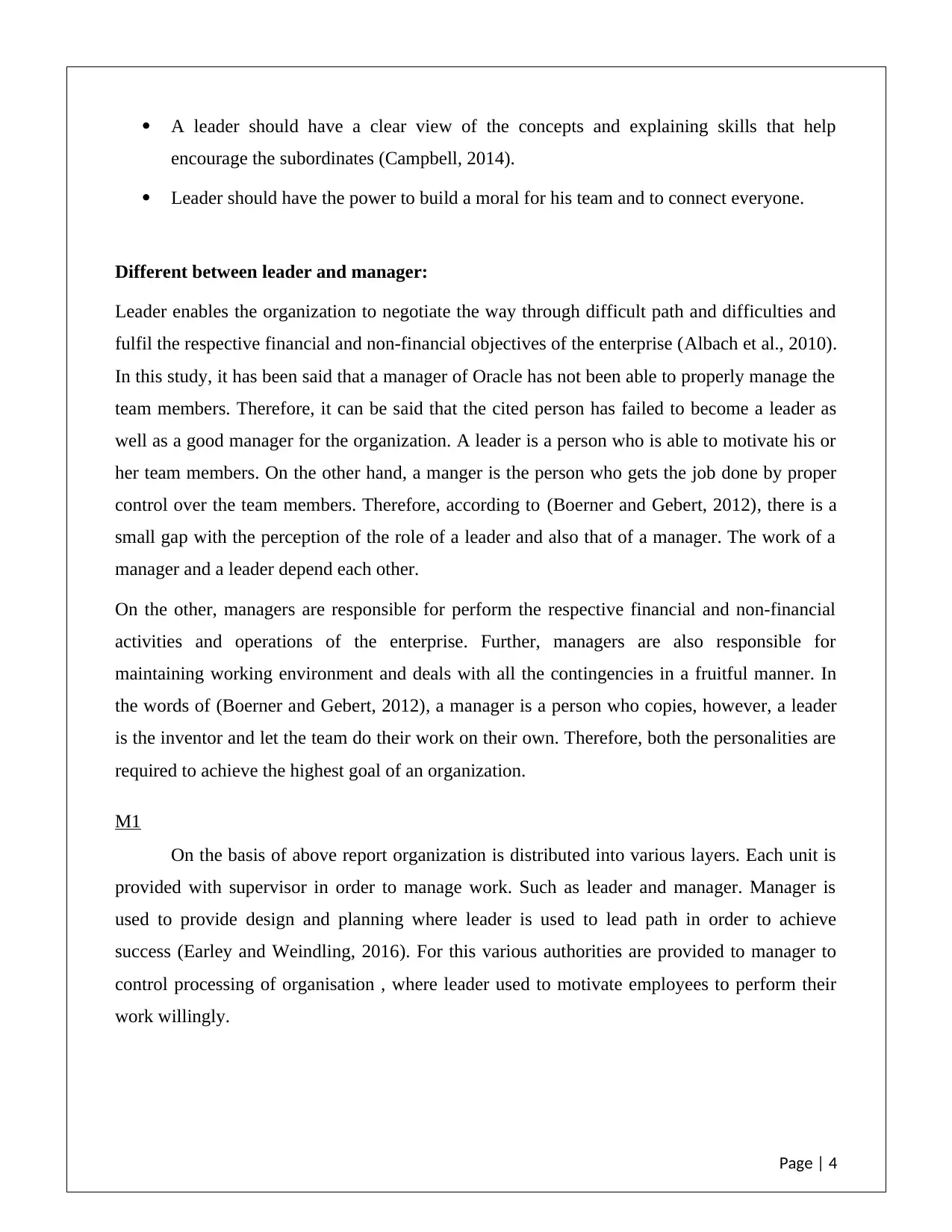
A leader should have a clear view of the concepts and explaining skills that help
encourage the subordinates (Campbell, 2014).
Leader should have the power to build a moral for his team and to connect everyone.
Different between leader and manager:
Leader enables the organization to negotiate the way through difficult path and difficulties and
fulfil the respective financial and non-financial objectives of the enterprise (Albach et al., 2010).
In this study, it has been said that a manager of Oracle has not been able to properly manage the
team members. Therefore, it can be said that the cited person has failed to become a leader as
well as a good manager for the organization. A leader is a person who is able to motivate his or
her team members. On the other hand, a manger is the person who gets the job done by proper
control over the team members. Therefore, according to (Boerner and Gebert, 2012), there is a
small gap with the perception of the role of a leader and also that of a manager. The work of a
manager and a leader depend each other.
On the other, managers are responsible for perform the respective financial and non-financial
activities and operations of the enterprise. Further, managers are also responsible for
maintaining working environment and deals with all the contingencies in a fruitful manner. In
the words of (Boerner and Gebert, 2012), a manager is a person who copies, however, a leader
is the inventor and let the team do their work on their own. Therefore, both the personalities are
required to achieve the highest goal of an organization.
M1
On the basis of above report organization is distributed into various layers. Each unit is
provided with supervisor in order to manage work. Such as leader and manager. Manager is
used to provide design and planning where leader is used to lead path in order to achieve
success (Earley and Weindling, 2016). For this various authorities are provided to manager to
control processing of organisation , where leader used to motivate employees to perform their
work willingly.
Page | 4
encourage the subordinates (Campbell, 2014).
Leader should have the power to build a moral for his team and to connect everyone.
Different between leader and manager:
Leader enables the organization to negotiate the way through difficult path and difficulties and
fulfil the respective financial and non-financial objectives of the enterprise (Albach et al., 2010).
In this study, it has been said that a manager of Oracle has not been able to properly manage the
team members. Therefore, it can be said that the cited person has failed to become a leader as
well as a good manager for the organization. A leader is a person who is able to motivate his or
her team members. On the other hand, a manger is the person who gets the job done by proper
control over the team members. Therefore, according to (Boerner and Gebert, 2012), there is a
small gap with the perception of the role of a leader and also that of a manager. The work of a
manager and a leader depend each other.
On the other, managers are responsible for perform the respective financial and non-financial
activities and operations of the enterprise. Further, managers are also responsible for
maintaining working environment and deals with all the contingencies in a fruitful manner. In
the words of (Boerner and Gebert, 2012), a manager is a person who copies, however, a leader
is the inventor and let the team do their work on their own. Therefore, both the personalities are
required to achieve the highest goal of an organization.
M1
On the basis of above report organization is distributed into various layers. Each unit is
provided with supervisor in order to manage work. Such as leader and manager. Manager is
used to provide design and planning where leader is used to lead path in order to achieve
success (Earley and Weindling, 2016). For this various authorities are provided to manager to
control processing of organisation , where leader used to motivate employees to perform their
work willingly.
Page | 4
Paraphrase This Document
Need a fresh take? Get an instant paraphrase of this document with our AI Paraphraser

Describing the different roles of management and leadership in application to different
organizational situations supported by theories:
Role of leader is to guide and role of manager is to perform:
In this case, it has been observed that management and leadership is two different aspects of
operational conducts. There are some instances where leadership is required, whereas in other
cases perfect managerial skills are sought. Therefore, a subtle differentiation between the two is
required (Grint, K. 2015). Moreover, leaders decide the betterment of the enterprise and frame
necessary objectives while managers follow the instructions of the leaders and contribute
towards securing the position and status of the organization (Campbell, 2014).
Framing of objectives and completion of activities:
It is not to be mentioned that leaders are the one which frame relevant and reasonable objectives
and goals for the betterment of the enterprise so as to boost the financial performance of the
entity in the market place. On the other hand, it is the responsibility of the manager to complete
or execute the plans in an appropriate manner and fulfill the above framed objectives and goals.
The manager has to supervise all of his team members and also order them. However, a selling
leadership is the provocation technique. In this leadership program, a leader tries to sell his or
her idea to know the reaction of the team members. Here, it can be said that this is required
when the members are willing to do a job but do not have the idea. However, it can also be
inferred from this leadership technique that here the members are efficient but cannot find a
proper way to start (Campbell, 2014).
Setting of targets and implementation of projects:
Setting and completion of targets and objective is necessary for organizations to move
systematically in the market place. Linking the same, while leaders set the targets, managers
implements necessary techniques to fulfill the same. Here, the participants are more prominent
and possess the ability to complete the tasks; however, the unwillingness of taking responsibility
makes a leader to enter into the team effort. The delegating leadership is for the team members
who are efficient and also willing to take up charge to complete a task. They take
responsibilities. Therefore, it can be said that this leadership is only to handle the members who
are experienced and matured (Earley, 2012).
Page | 5
organizational situations supported by theories:
Role of leader is to guide and role of manager is to perform:
In this case, it has been observed that management and leadership is two different aspects of
operational conducts. There are some instances where leadership is required, whereas in other
cases perfect managerial skills are sought. Therefore, a subtle differentiation between the two is
required (Grint, K. 2015). Moreover, leaders decide the betterment of the enterprise and frame
necessary objectives while managers follow the instructions of the leaders and contribute
towards securing the position and status of the organization (Campbell, 2014).
Framing of objectives and completion of activities:
It is not to be mentioned that leaders are the one which frame relevant and reasonable objectives
and goals for the betterment of the enterprise so as to boost the financial performance of the
entity in the market place. On the other hand, it is the responsibility of the manager to complete
or execute the plans in an appropriate manner and fulfill the above framed objectives and goals.
The manager has to supervise all of his team members and also order them. However, a selling
leadership is the provocation technique. In this leadership program, a leader tries to sell his or
her idea to know the reaction of the team members. Here, it can be said that this is required
when the members are willing to do a job but do not have the idea. However, it can also be
inferred from this leadership technique that here the members are efficient but cannot find a
proper way to start (Campbell, 2014).
Setting of targets and implementation of projects:
Setting and completion of targets and objective is necessary for organizations to move
systematically in the market place. Linking the same, while leaders set the targets, managers
implements necessary techniques to fulfill the same. Here, the participants are more prominent
and possess the ability to complete the tasks; however, the unwillingness of taking responsibility
makes a leader to enter into the team effort. The delegating leadership is for the team members
who are efficient and also willing to take up charge to complete a task. They take
responsibilities. Therefore, it can be said that this leadership is only to handle the members who
are experienced and matured (Earley, 2012).
Page | 5
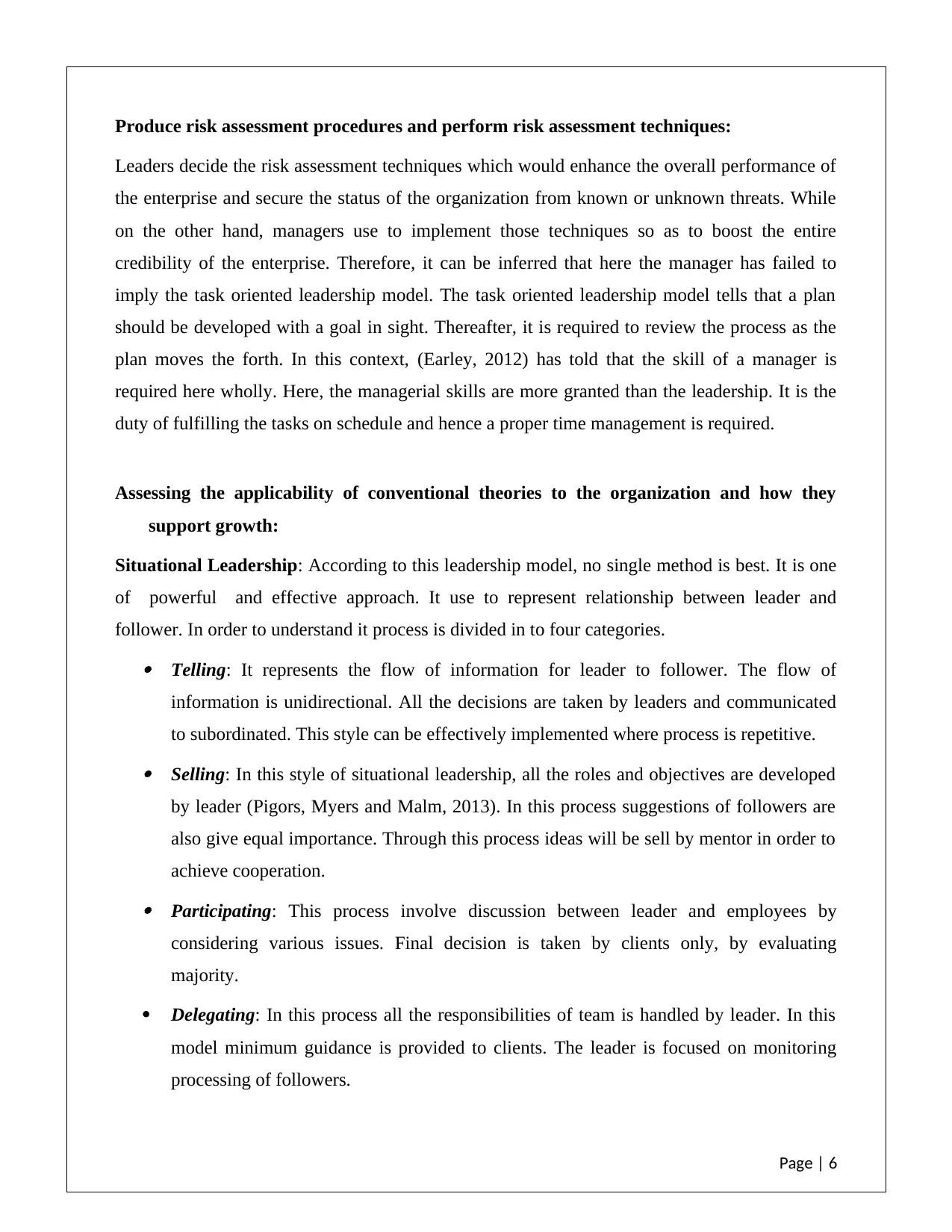
Produce risk assessment procedures and perform risk assessment techniques:
Leaders decide the risk assessment techniques which would enhance the overall performance of
the enterprise and secure the status of the organization from known or unknown threats. While
on the other hand, managers use to implement those techniques so as to boost the entire
credibility of the enterprise. Therefore, it can be inferred that here the manager has failed to
imply the task oriented leadership model. The task oriented leadership model tells that a plan
should be developed with a goal in sight. Thereafter, it is required to review the process as the
plan moves the forth. In this context, (Earley, 2012) has told that the skill of a manager is
required here wholly. Here, the managerial skills are more granted than the leadership. It is the
duty of fulfilling the tasks on schedule and hence a proper time management is required.
Assessing the applicability of conventional theories to the organization and how they
support growth:
Situational Leadership: According to this leadership model, no single method is best. It is one
of powerful and effective approach. It use to represent relationship between leader and
follower. In order to understand it process is divided in to four categories. Telling: It represents the flow of information for leader to follower. The flow of
information is unidirectional. All the decisions are taken by leaders and communicated
to subordinated. This style can be effectively implemented where process is repetitive. Selling: In this style of situational leadership, all the roles and objectives are developed
by leader (Pigors, Myers and Malm, 2013). In this process suggestions of followers are
also give equal importance. Through this process ideas will be sell by mentor in order to
achieve cooperation. Participating: This process involve discussion between leader and employees by
considering various issues. Final decision is taken by clients only, by evaluating
majority.
Delegating: In this process all the responsibilities of team is handled by leader. In this
model minimum guidance is provided to clients. The leader is focused on monitoring
processing of followers.
Page | 6
Leaders decide the risk assessment techniques which would enhance the overall performance of
the enterprise and secure the status of the organization from known or unknown threats. While
on the other hand, managers use to implement those techniques so as to boost the entire
credibility of the enterprise. Therefore, it can be inferred that here the manager has failed to
imply the task oriented leadership model. The task oriented leadership model tells that a plan
should be developed with a goal in sight. Thereafter, it is required to review the process as the
plan moves the forth. In this context, (Earley, 2012) has told that the skill of a manager is
required here wholly. Here, the managerial skills are more granted than the leadership. It is the
duty of fulfilling the tasks on schedule and hence a proper time management is required.
Assessing the applicability of conventional theories to the organization and how they
support growth:
Situational Leadership: According to this leadership model, no single method is best. It is one
of powerful and effective approach. It use to represent relationship between leader and
follower. In order to understand it process is divided in to four categories. Telling: It represents the flow of information for leader to follower. The flow of
information is unidirectional. All the decisions are taken by leaders and communicated
to subordinated. This style can be effectively implemented where process is repetitive. Selling: In this style of situational leadership, all the roles and objectives are developed
by leader (Pigors, Myers and Malm, 2013). In this process suggestions of followers are
also give equal importance. Through this process ideas will be sell by mentor in order to
achieve cooperation. Participating: This process involve discussion between leader and employees by
considering various issues. Final decision is taken by clients only, by evaluating
majority.
Delegating: In this process all the responsibilities of team is handled by leader. In this
model minimum guidance is provided to clients. The leader is focused on monitoring
processing of followers.
Page | 6
⊘ This is a preview!⊘
Do you want full access?
Subscribe today to unlock all pages.

Trusted by 1+ million students worldwide
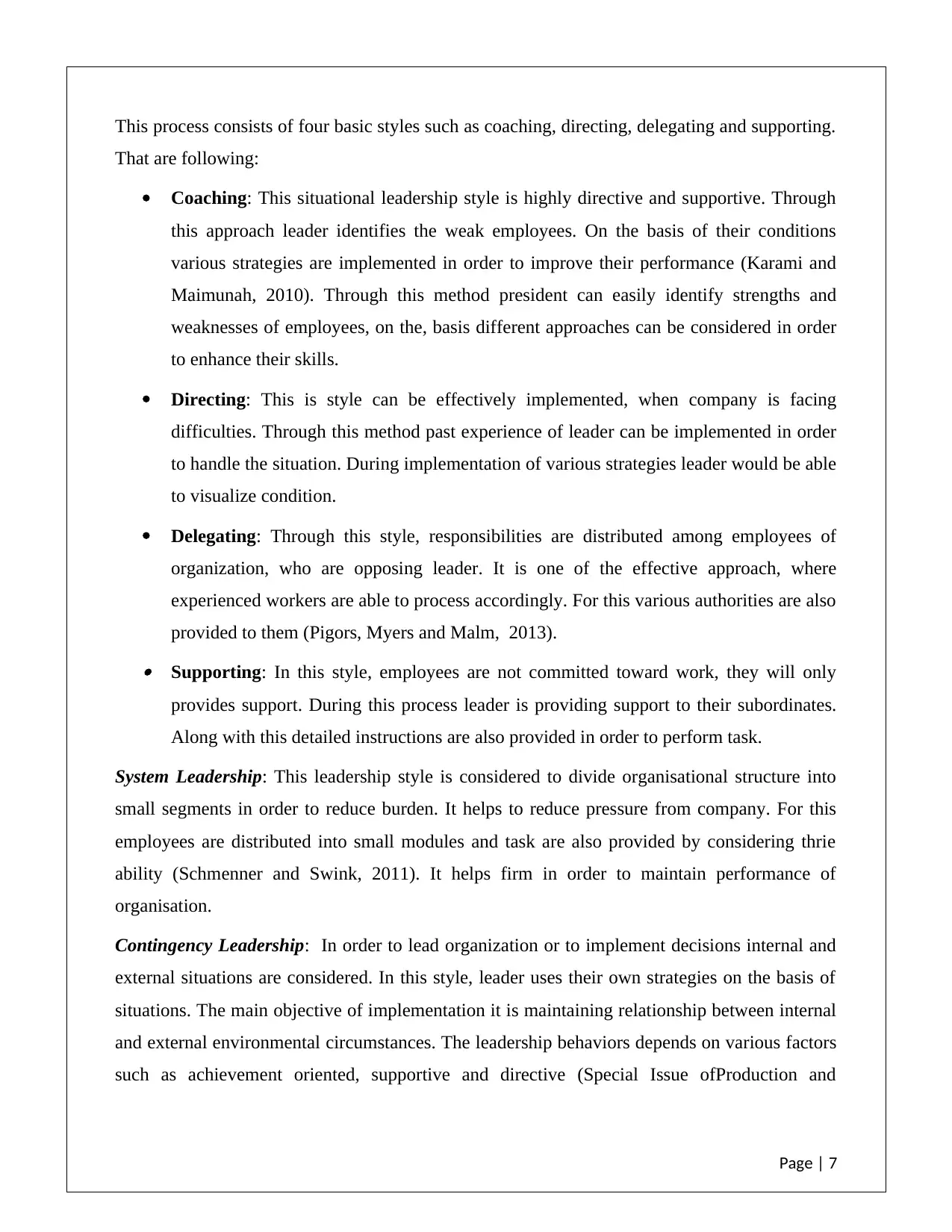
This process consists of four basic styles such as coaching, directing, delegating and supporting.
That are following:
Coaching: This situational leadership style is highly directive and supportive. Through
this approach leader identifies the weak employees. On the basis of their conditions
various strategies are implemented in order to improve their performance (Karami and
Maimunah, 2010). Through this method president can easily identify strengths and
weaknesses of employees, on the, basis different approaches can be considered in order
to enhance their skills.
Directing: This is style can be effectively implemented, when company is facing
difficulties. Through this method past experience of leader can be implemented in order
to handle the situation. During implementation of various strategies leader would be able
to visualize condition.
Delegating: Through this style, responsibilities are distributed among employees of
organization, who are opposing leader. It is one of the effective approach, where
experienced workers are able to process accordingly. For this various authorities are also
provided to them (Pigors, Myers and Malm, 2013). Supporting: In this style, employees are not committed toward work, they will only
provides support. During this process leader is providing support to their subordinates.
Along with this detailed instructions are also provided in order to perform task.
System Leadership: This leadership style is considered to divide organisational structure into
small segments in order to reduce burden. It helps to reduce pressure from company. For this
employees are distributed into small modules and task are also provided by considering thrie
ability (Schmenner and Swink, 2011). It helps firm in order to maintain performance of
organisation.
Contingency Leadership: In order to lead organization or to implement decisions internal and
external situations are considered. In this style, leader uses their own strategies on the basis of
situations. The main objective of implementation it is maintaining relationship between internal
and external environmental circumstances. The leadership behaviors depends on various factors
such as achievement oriented, supportive and directive (Special Issue ofProduction and
Page | 7
That are following:
Coaching: This situational leadership style is highly directive and supportive. Through
this approach leader identifies the weak employees. On the basis of their conditions
various strategies are implemented in order to improve their performance (Karami and
Maimunah, 2010). Through this method president can easily identify strengths and
weaknesses of employees, on the, basis different approaches can be considered in order
to enhance their skills.
Directing: This is style can be effectively implemented, when company is facing
difficulties. Through this method past experience of leader can be implemented in order
to handle the situation. During implementation of various strategies leader would be able
to visualize condition.
Delegating: Through this style, responsibilities are distributed among employees of
organization, who are opposing leader. It is one of the effective approach, where
experienced workers are able to process accordingly. For this various authorities are also
provided to them (Pigors, Myers and Malm, 2013). Supporting: In this style, employees are not committed toward work, they will only
provides support. During this process leader is providing support to their subordinates.
Along with this detailed instructions are also provided in order to perform task.
System Leadership: This leadership style is considered to divide organisational structure into
small segments in order to reduce burden. It helps to reduce pressure from company. For this
employees are distributed into small modules and task are also provided by considering thrie
ability (Schmenner and Swink, 2011). It helps firm in order to maintain performance of
organisation.
Contingency Leadership: In order to lead organization or to implement decisions internal and
external situations are considered. In this style, leader uses their own strategies on the basis of
situations. The main objective of implementation it is maintaining relationship between internal
and external environmental circumstances. The leadership behaviors depends on various factors
such as achievement oriented, supportive and directive (Special Issue ofProduction and
Page | 7
Paraphrase This Document
Need a fresh take? Get an instant paraphrase of this document with our AI Paraphraser
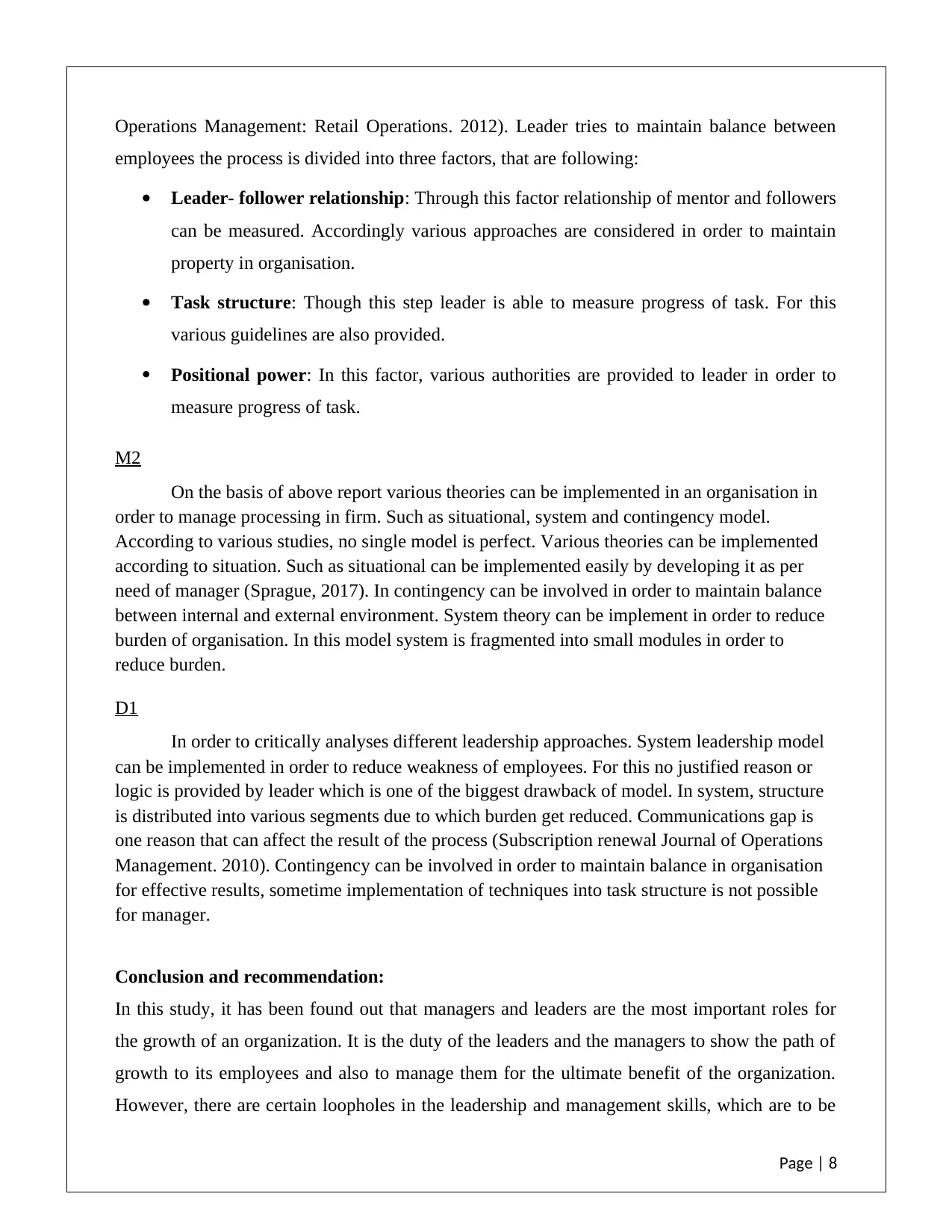
Operations Management: Retail Operations. 2012). Leader tries to maintain balance between
employees the process is divided into three factors, that are following:
Leader- follower relationship: Through this factor relationship of mentor and followers
can be measured. Accordingly various approaches are considered in order to maintain
property in organisation.
Task structure: Though this step leader is able to measure progress of task. For this
various guidelines are also provided.
Positional power: In this factor, various authorities are provided to leader in order to
measure progress of task.
M2
On the basis of above report various theories can be implemented in an organisation in
order to manage processing in firm. Such as situational, system and contingency model.
According to various studies, no single model is perfect. Various theories can be implemented
according to situation. Such as situational can be implemented easily by developing it as per
need of manager (Sprague, 2017). In contingency can be involved in order to maintain balance
between internal and external environment. System theory can be implement in order to reduce
burden of organisation. In this model system is fragmented into small modules in order to
reduce burden.
D1
In order to critically analyses different leadership approaches. System leadership model
can be implemented in order to reduce weakness of employees. For this no justified reason or
logic is provided by leader which is one of the biggest drawback of model. In system, structure
is distributed into various segments due to which burden get reduced. Communications gap is
one reason that can affect the result of the process (Subscription renewal Journal of Operations
Management. 2010). Contingency can be involved in order to maintain balance in organisation
for effective results, sometime implementation of techniques into task structure is not possible
for manager.
Conclusion and recommendation:
In this study, it has been found out that managers and leaders are the most important roles for
the growth of an organization. It is the duty of the leaders and the managers to show the path of
growth to its employees and also to manage them for the ultimate benefit of the organization.
However, there are certain loopholes in the leadership and management skills, which are to be
Page | 8
employees the process is divided into three factors, that are following:
Leader- follower relationship: Through this factor relationship of mentor and followers
can be measured. Accordingly various approaches are considered in order to maintain
property in organisation.
Task structure: Though this step leader is able to measure progress of task. For this
various guidelines are also provided.
Positional power: In this factor, various authorities are provided to leader in order to
measure progress of task.
M2
On the basis of above report various theories can be implemented in an organisation in
order to manage processing in firm. Such as situational, system and contingency model.
According to various studies, no single model is perfect. Various theories can be implemented
according to situation. Such as situational can be implemented easily by developing it as per
need of manager (Sprague, 2017). In contingency can be involved in order to maintain balance
between internal and external environment. System theory can be implement in order to reduce
burden of organisation. In this model system is fragmented into small modules in order to
reduce burden.
D1
In order to critically analyses different leadership approaches. System leadership model
can be implemented in order to reduce weakness of employees. For this no justified reason or
logic is provided by leader which is one of the biggest drawback of model. In system, structure
is distributed into various segments due to which burden get reduced. Communications gap is
one reason that can affect the result of the process (Subscription renewal Journal of Operations
Management. 2010). Contingency can be involved in order to maintain balance in organisation
for effective results, sometime implementation of techniques into task structure is not possible
for manager.
Conclusion and recommendation:
In this study, it has been found out that managers and leaders are the most important roles for
the growth of an organization. It is the duty of the leaders and the managers to show the path of
growth to its employees and also to manage them for the ultimate benefit of the organization.
However, there are certain loopholes in the leadership and management skills, which are to be
Page | 8
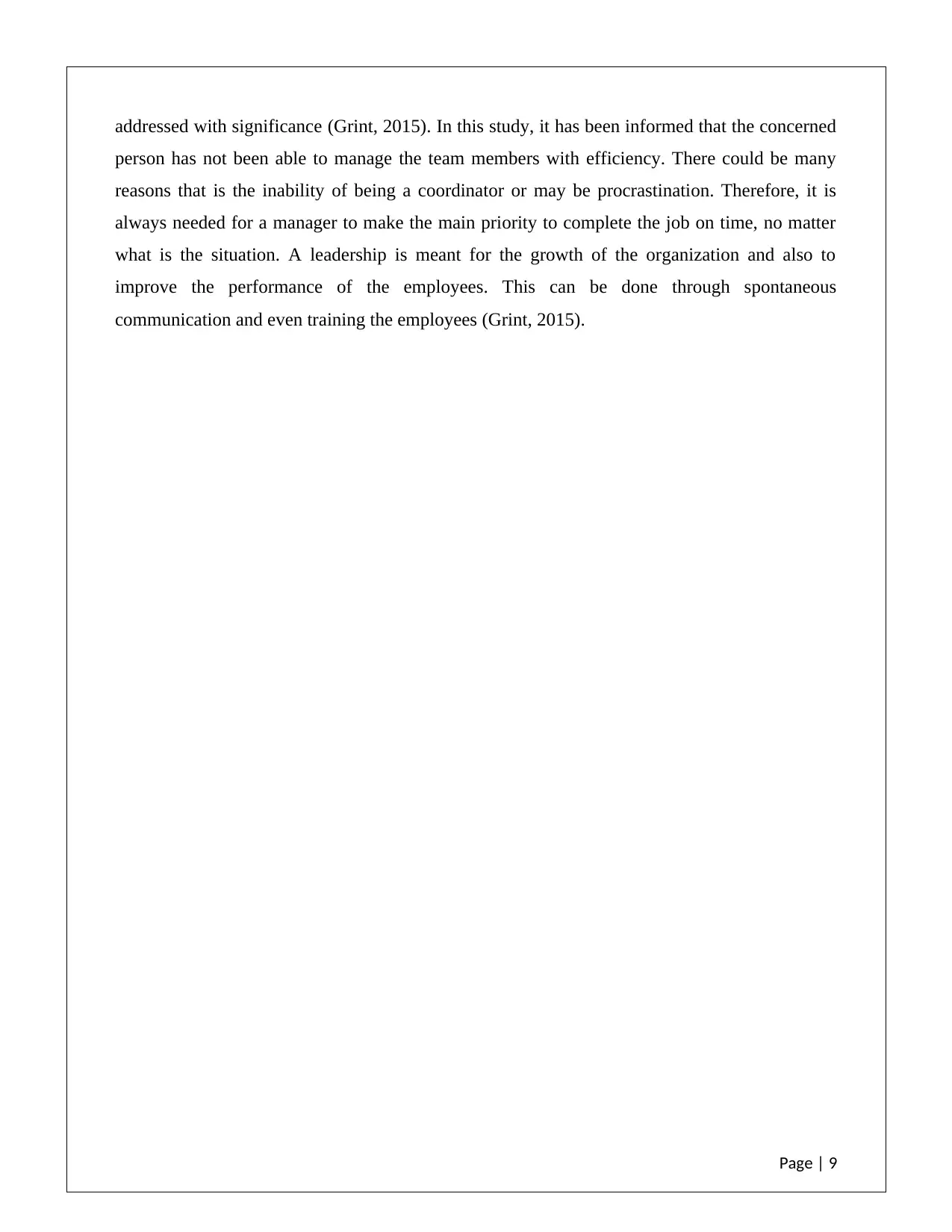
addressed with significance (Grint, 2015). In this study, it has been informed that the concerned
person has not been able to manage the team members with efficiency. There could be many
reasons that is the inability of being a coordinator or may be procrastination. Therefore, it is
always needed for a manager to make the main priority to complete the job on time, no matter
what is the situation. A leadership is meant for the growth of the organization and also to
improve the performance of the employees. This can be done through spontaneous
communication and even training the employees (Grint, 2015).
Page | 9
person has not been able to manage the team members with efficiency. There could be many
reasons that is the inability of being a coordinator or may be procrastination. Therefore, it is
always needed for a manager to make the main priority to complete the job on time, no matter
what is the situation. A leadership is meant for the growth of the organization and also to
improve the performance of the employees. This can be done through spontaneous
communication and even training the employees (Grint, 2015).
Page | 9
⊘ This is a preview!⊘
Do you want full access?
Subscribe today to unlock all pages.

Trusted by 1+ million students worldwide
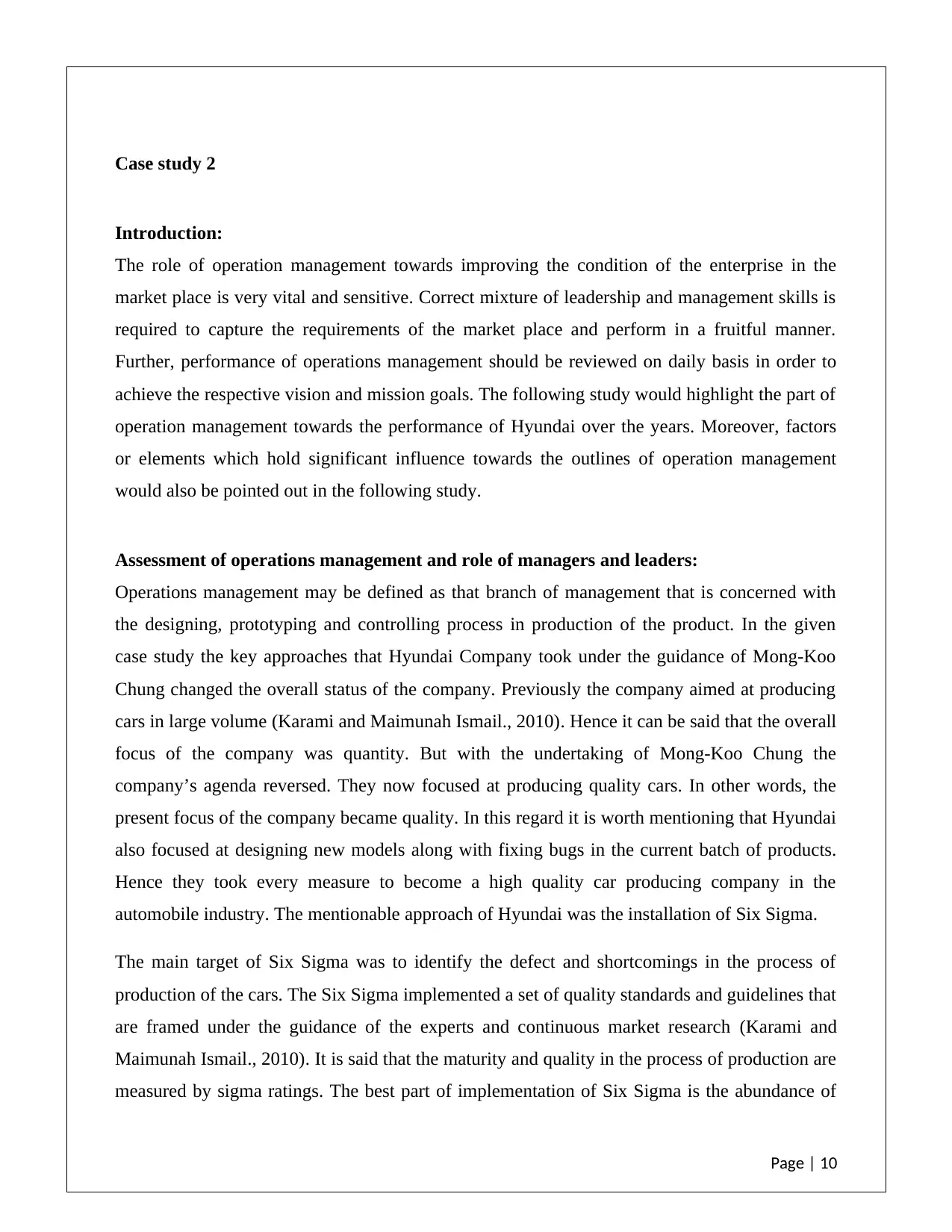
Case study 2
Introduction:
The role of operation management towards improving the condition of the enterprise in the
market place is very vital and sensitive. Correct mixture of leadership and management skills is
required to capture the requirements of the market place and perform in a fruitful manner.
Further, performance of operations management should be reviewed on daily basis in order to
achieve the respective vision and mission goals. The following study would highlight the part of
operation management towards the performance of Hyundai over the years. Moreover, factors
or elements which hold significant influence towards the outlines of operation management
would also be pointed out in the following study.
Assessment of operations management and role of managers and leaders:
Operations management may be defined as that branch of management that is concerned with
the designing, prototyping and controlling process in production of the product. In the given
case study the key approaches that Hyundai Company took under the guidance of Mong-Koo
Chung changed the overall status of the company. Previously the company aimed at producing
cars in large volume (Karami and Maimunah Ismail., 2010). Hence it can be said that the overall
focus of the company was quantity. But with the undertaking of Mong-Koo Chung the
company’s agenda reversed. They now focused at producing quality cars. In other words, the
present focus of the company became quality. In this regard it is worth mentioning that Hyundai
also focused at designing new models along with fixing bugs in the current batch of products.
Hence they took every measure to become a high quality car producing company in the
automobile industry. The mentionable approach of Hyundai was the installation of Six Sigma.
The main target of Six Sigma was to identify the defect and shortcomings in the process of
production of the cars. The Six Sigma implemented a set of quality standards and guidelines that
are framed under the guidance of the experts and continuous market research (Karami and
Maimunah Ismail., 2010). It is said that the maturity and quality in the process of production are
measured by sigma ratings. The best part of implementation of Six Sigma is the abundance of
Page | 10
Introduction:
The role of operation management towards improving the condition of the enterprise in the
market place is very vital and sensitive. Correct mixture of leadership and management skills is
required to capture the requirements of the market place and perform in a fruitful manner.
Further, performance of operations management should be reviewed on daily basis in order to
achieve the respective vision and mission goals. The following study would highlight the part of
operation management towards the performance of Hyundai over the years. Moreover, factors
or elements which hold significant influence towards the outlines of operation management
would also be pointed out in the following study.
Assessment of operations management and role of managers and leaders:
Operations management may be defined as that branch of management that is concerned with
the designing, prototyping and controlling process in production of the product. In the given
case study the key approaches that Hyundai Company took under the guidance of Mong-Koo
Chung changed the overall status of the company. Previously the company aimed at producing
cars in large volume (Karami and Maimunah Ismail., 2010). Hence it can be said that the overall
focus of the company was quantity. But with the undertaking of Mong-Koo Chung the
company’s agenda reversed. They now focused at producing quality cars. In other words, the
present focus of the company became quality. In this regard it is worth mentioning that Hyundai
also focused at designing new models along with fixing bugs in the current batch of products.
Hence they took every measure to become a high quality car producing company in the
automobile industry. The mentionable approach of Hyundai was the installation of Six Sigma.
The main target of Six Sigma was to identify the defect and shortcomings in the process of
production of the cars. The Six Sigma implemented a set of quality standards and guidelines that
are framed under the guidance of the experts and continuous market research (Karami and
Maimunah Ismail., 2010). It is said that the maturity and quality in the process of production are
measured by sigma ratings. The best part of implementation of Six Sigma is the abundance of
Page | 10
Paraphrase This Document
Need a fresh take? Get an instant paraphrase of this document with our AI Paraphraser
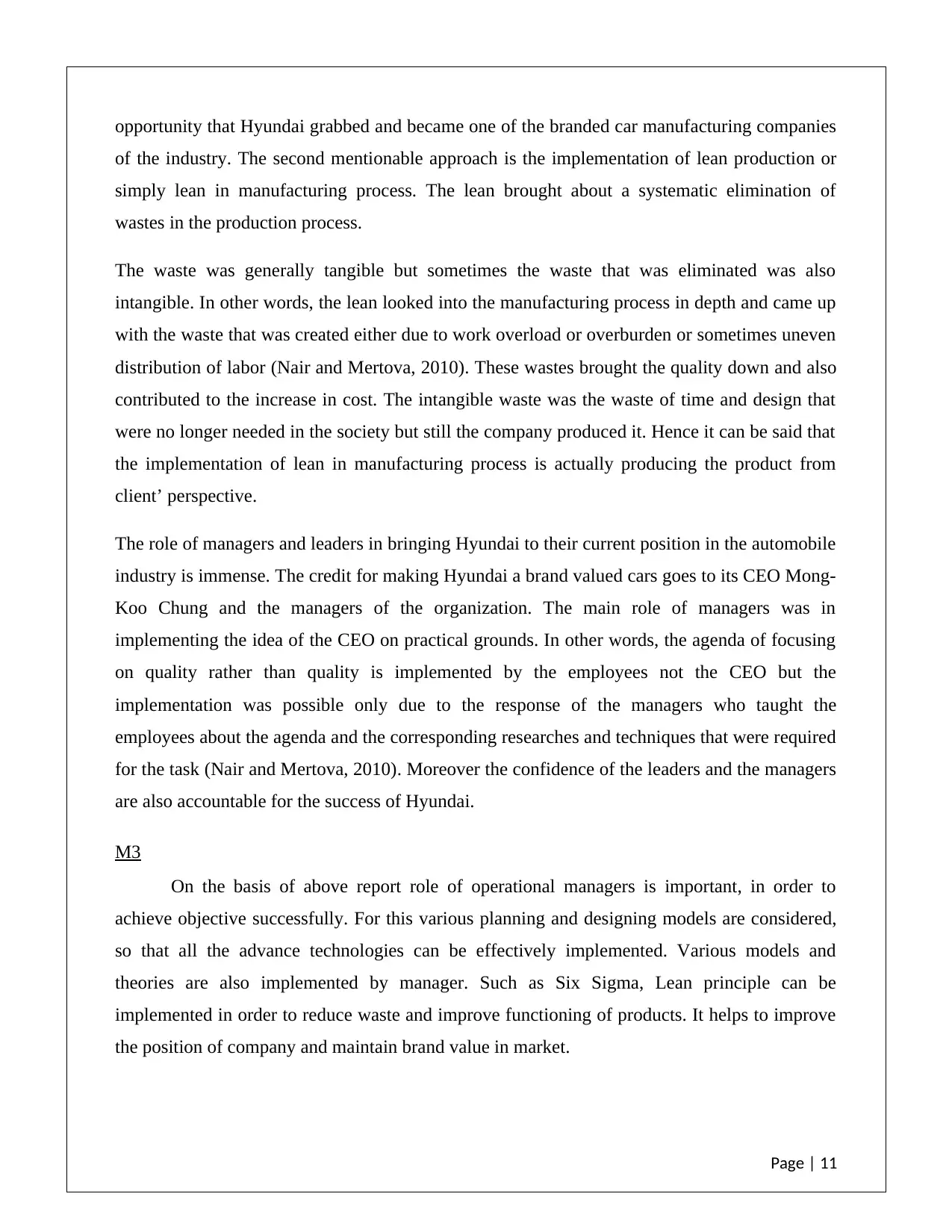
opportunity that Hyundai grabbed and became one of the branded car manufacturing companies
of the industry. The second mentionable approach is the implementation of lean production or
simply lean in manufacturing process. The lean brought about a systematic elimination of
wastes in the production process.
The waste was generally tangible but sometimes the waste that was eliminated was also
intangible. In other words, the lean looked into the manufacturing process in depth and came up
with the waste that was created either due to work overload or overburden or sometimes uneven
distribution of labor (Nair and Mertova, 2010). These wastes brought the quality down and also
contributed to the increase in cost. The intangible waste was the waste of time and design that
were no longer needed in the society but still the company produced it. Hence it can be said that
the implementation of lean in manufacturing process is actually producing the product from
client’ perspective.
The role of managers and leaders in bringing Hyundai to their current position in the automobile
industry is immense. The credit for making Hyundai a brand valued cars goes to its CEO Mong-
Koo Chung and the managers of the organization. The main role of managers was in
implementing the idea of the CEO on practical grounds. In other words, the agenda of focusing
on quality rather than quality is implemented by the employees not the CEO but the
implementation was possible only due to the response of the managers who taught the
employees about the agenda and the corresponding researches and techniques that were required
for the task (Nair and Mertova, 2010). Moreover the confidence of the leaders and the managers
are also accountable for the success of Hyundai.
M3
On the basis of above report role of operational managers is important, in order to
achieve objective successfully. For this various planning and designing models are considered,
so that all the advance technologies can be effectively implemented. Various models and
theories are also implemented by manager. Such as Six Sigma, Lean principle can be
implemented in order to reduce waste and improve functioning of products. It helps to improve
the position of company and maintain brand value in market.
Page | 11
of the industry. The second mentionable approach is the implementation of lean production or
simply lean in manufacturing process. The lean brought about a systematic elimination of
wastes in the production process.
The waste was generally tangible but sometimes the waste that was eliminated was also
intangible. In other words, the lean looked into the manufacturing process in depth and came up
with the waste that was created either due to work overload or overburden or sometimes uneven
distribution of labor (Nair and Mertova, 2010). These wastes brought the quality down and also
contributed to the increase in cost. The intangible waste was the waste of time and design that
were no longer needed in the society but still the company produced it. Hence it can be said that
the implementation of lean in manufacturing process is actually producing the product from
client’ perspective.
The role of managers and leaders in bringing Hyundai to their current position in the automobile
industry is immense. The credit for making Hyundai a brand valued cars goes to its CEO Mong-
Koo Chung and the managers of the organization. The main role of managers was in
implementing the idea of the CEO on practical grounds. In other words, the agenda of focusing
on quality rather than quality is implemented by the employees not the CEO but the
implementation was possible only due to the response of the managers who taught the
employees about the agenda and the corresponding researches and techniques that were required
for the task (Nair and Mertova, 2010). Moreover the confidence of the leaders and the managers
are also accountable for the success of Hyundai.
M3
On the basis of above report role of operational managers is important, in order to
achieve objective successfully. For this various planning and designing models are considered,
so that all the advance technologies can be effectively implemented. Various models and
theories are also implemented by manager. Such as Six Sigma, Lean principle can be
implemented in order to reduce waste and improve functioning of products. It helps to improve
the position of company and maintain brand value in market.
Page | 11
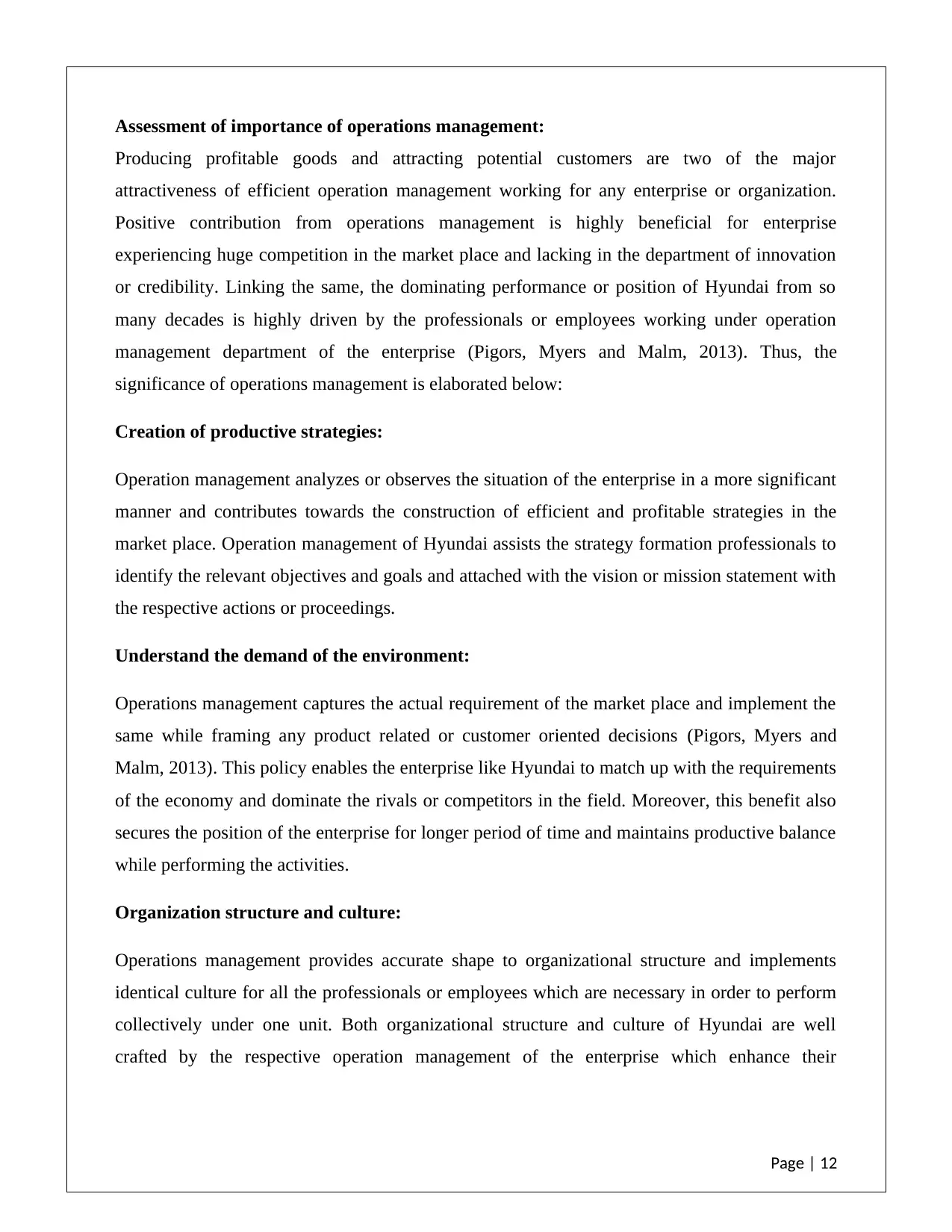
Assessment of importance of operations management:
Producing profitable goods and attracting potential customers are two of the major
attractiveness of efficient operation management working for any enterprise or organization.
Positive contribution from operations management is highly beneficial for enterprise
experiencing huge competition in the market place and lacking in the department of innovation
or credibility. Linking the same, the dominating performance or position of Hyundai from so
many decades is highly driven by the professionals or employees working under operation
management department of the enterprise (Pigors, Myers and Malm, 2013). Thus, the
significance of operations management is elaborated below:
Creation of productive strategies:
Operation management analyzes or observes the situation of the enterprise in a more significant
manner and contributes towards the construction of efficient and profitable strategies in the
market place. Operation management of Hyundai assists the strategy formation professionals to
identify the relevant objectives and goals and attached with the vision or mission statement with
the respective actions or proceedings.
Understand the demand of the environment:
Operations management captures the actual requirement of the market place and implement the
same while framing any product related or customer oriented decisions (Pigors, Myers and
Malm, 2013). This policy enables the enterprise like Hyundai to match up with the requirements
of the economy and dominate the rivals or competitors in the field. Moreover, this benefit also
secures the position of the enterprise for longer period of time and maintains productive balance
while performing the activities.
Organization structure and culture:
Operations management provides accurate shape to organizational structure and implements
identical culture for all the professionals or employees which are necessary in order to perform
collectively under one unit. Both organizational structure and culture of Hyundai are well
crafted by the respective operation management of the enterprise which enhance their
Page | 12
Producing profitable goods and attracting potential customers are two of the major
attractiveness of efficient operation management working for any enterprise or organization.
Positive contribution from operations management is highly beneficial for enterprise
experiencing huge competition in the market place and lacking in the department of innovation
or credibility. Linking the same, the dominating performance or position of Hyundai from so
many decades is highly driven by the professionals or employees working under operation
management department of the enterprise (Pigors, Myers and Malm, 2013). Thus, the
significance of operations management is elaborated below:
Creation of productive strategies:
Operation management analyzes or observes the situation of the enterprise in a more significant
manner and contributes towards the construction of efficient and profitable strategies in the
market place. Operation management of Hyundai assists the strategy formation professionals to
identify the relevant objectives and goals and attached with the vision or mission statement with
the respective actions or proceedings.
Understand the demand of the environment:
Operations management captures the actual requirement of the market place and implement the
same while framing any product related or customer oriented decisions (Pigors, Myers and
Malm, 2013). This policy enables the enterprise like Hyundai to match up with the requirements
of the economy and dominate the rivals or competitors in the field. Moreover, this benefit also
secures the position of the enterprise for longer period of time and maintains productive balance
while performing the activities.
Organization structure and culture:
Operations management provides accurate shape to organizational structure and implements
identical culture for all the professionals or employees which are necessary in order to perform
collectively under one unit. Both organizational structure and culture of Hyundai are well
crafted by the respective operation management of the enterprise which enhance their
Page | 12
⊘ This is a preview!⊘
Do you want full access?
Subscribe today to unlock all pages.

Trusted by 1+ million students worldwide
1 out of 17
Related Documents
Your All-in-One AI-Powered Toolkit for Academic Success.
+13062052269
info@desklib.com
Available 24*7 on WhatsApp / Email
![[object Object]](/_next/static/media/star-bottom.7253800d.svg)
Unlock your academic potential
Copyright © 2020–2025 A2Z Services. All Rights Reserved. Developed and managed by ZUCOL.





